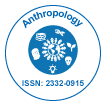
Anthropology
Open Access
ISSN: 2332-0915

ISSN: 2332-0915
Perspective - (2023)Volume 11, Issue 4
Human society is a complex web of relationships, norms, and institutions that has evolved over millennia. Understanding the origins of society is a journey that takes back to the earliest days of human existence. The development of social structures was a crucial step in the evolution of Homo sapiens, marking a departure from solitary existence to cooperative living. This article explores the origins of society, examining key factors that contributed to the formation and evolution of human social structures.
The transition from solitude to society
The transition from solitary existence to social living was a pivotal moment in human history. Early humans, like their primate ancestors, initially lived in small family groups for protection and resource sharing. However, as the human brain developed and social dynamics became more complex, the advantages of communal living became increasingly apparent.
One of the fundamental driving forces behind the formation of early societies was the need for collective defense against external threats. In a harsh and unpredictable environment, cooperation provided a survival advantage. The ability to work together to prevent predators, secure resources, and navigate inspiring landscapes laid the foundation for social bonds among early humans.
Language and communication
The development of language played a crucial role in the formation of societies. Unlike other species, humans possess a sophisticated system of communication that allows for the transmission of complex ideas, emotions, and plans. Language facilitated cooperation, enabling early humans to coordinate activities, share knowledge, and form collective strategies.
As language evolved, so did the capacity for cultural transmission. Stories, rituals, and shared experiences were passed down through generations, creating a sense of identity and cohesion within groups. This cultural continuity became a defining feature of human societies, shaping values, norms, and social structures.
The role of cooperation in resource acquisition
Cooperation in resource acquisition was another key factor in the emergence of societies. Early humans discovered that hunting, gathering, and farming were more successful when undertaken collectively. The pooling of skills, knowledge, and labor allowed for the efficient exploitation of diverse environments.
Specialization of roles
As societies grew more complex, the specialization of roles became essential. Different individuals within a group began to specialize in specific tasks, such as hunting, gathering, toolmaking, and childcare. This division of labor not only increased efficiency but also fostered interdependence, reinforcing the interconnectedness of individuals within the social fabric.
The development of social structures
With the rise of agriculture around 10,000 Before the Current Era (BCE), humans transitioned from nomadic lifestyles to settled communities. This agricultural revolution marked a significant turning point, leading to the development of more permanent social structures. Villages and towns emerged, and social hierarchies based on factors like wealth, power, and expertise began to take shape.
The advent of organized religion and governance further solidified social structures. Religious beliefs provided a shared moral framework, while governance systems helped regulate behavior and resolve disputes. These institutions laid the groundwork for the diverse societies and civilizations that would emerge throughout history.
The origins of society are deeply rooted in the fundamental human drive for survival, cooperation, and communication. The transition from solitude to society was a gradual process shaped by environmental challenges, the development of language, and the benefits of collective living. As humans adapted to their surroundings, they forged social bonds, created cultural traditions, and established structures that continue to shape the intricate evolution of human societies today. Exploring the origins of society allows one to appreciate the remarkable journey that has brought every individual from small family groups to the complex and interconnected global communities one inhabits today.
Citation: Lehan S (2023) The Role of Specialization and Development of Social Structures in Resource Acquisition. Anthropology. 11:323.
Received: 27-Nov-2023, Manuscript No. ANTP-23-28584; Editor assigned: 30-Nov-2023, Pre QC No. ANTP-23-28584 (PQ); Reviewed: 14-Dec-2023, QC No. ANTP-23-28584; Revised: 21-Dec-2023, Manuscript No. ANTP-23-28584 (R); Published: 28-Dec-2023 , DOI: 10.35248/2332-0915.23.11.323
Copyright: © 2023 Lehan S. This is an open-access article distributed under the terms of the Creative Commons Attribution License, which permits unrestricted use, distribution, and reproduction in any medium, provided the original author and source are credited.